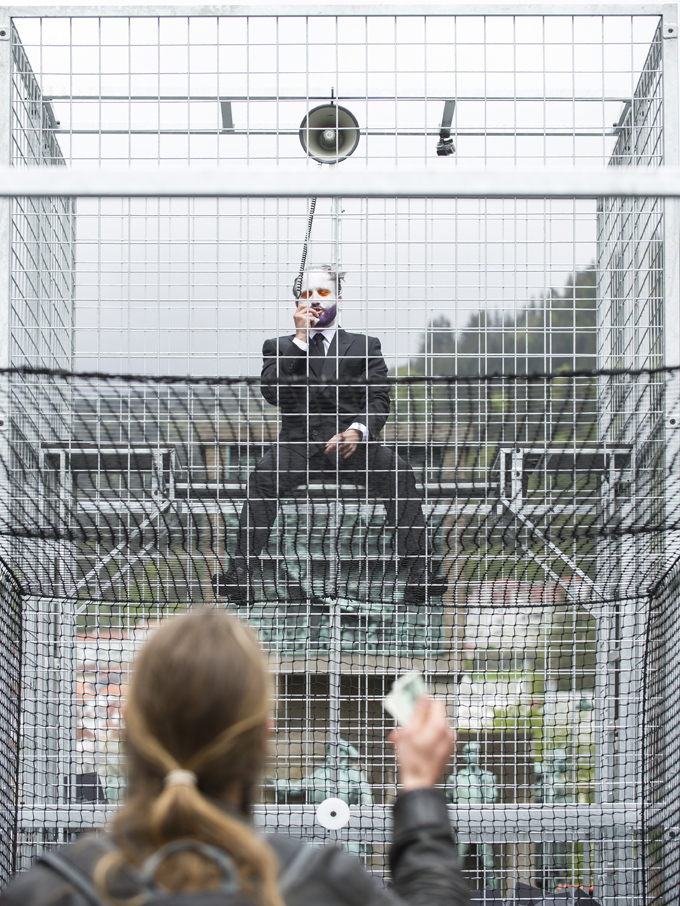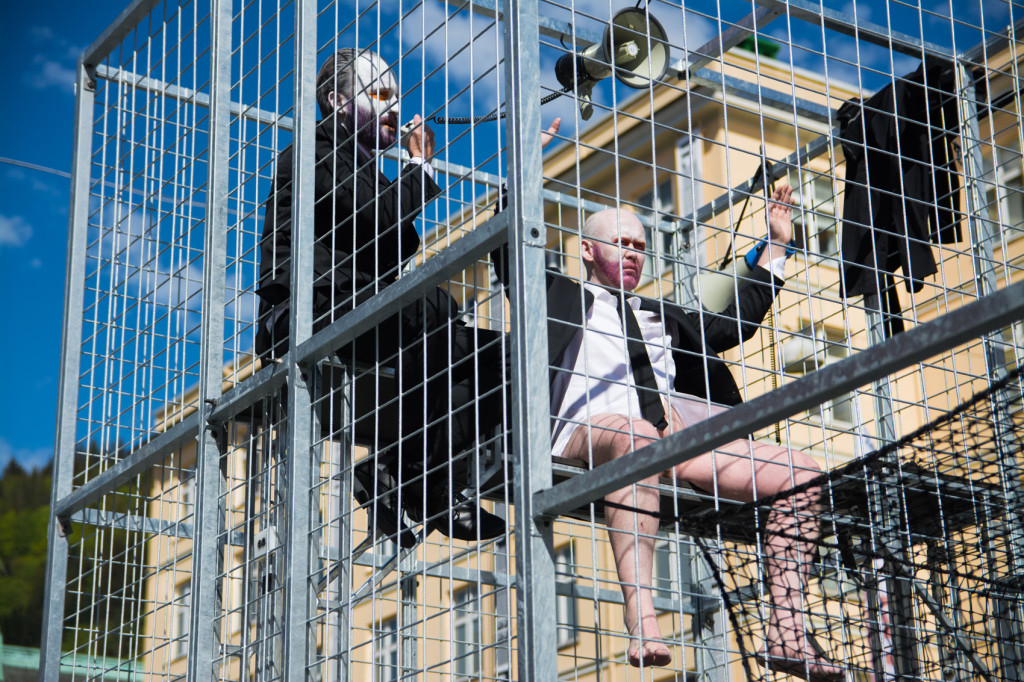The provocateur and the urban stories: Bergen, Stockholm, Aarhus, Dresden, Copenhagen

By Anders Beyer and Mary Aniella Petersen (Staatsschauspiel Dresden).
As THE PROVOCATEUR by Christian Lollike (a S/H production) will pass though cites in all tree Scandinavian countries and Germany between May 2015 and Spring 2016 parallel stories will emerge. These are the stories that appear at the point when the art work meets the audiences, or more precisely: the citizens of each city.
Then in this case the audiences will not be the regular theatre audience, who beforehand has purged a ticket for an evening show. On the contrary, the audiences confronted with this work in all five cities are citizens of the each individual city, and as a consequence during this intercourse other stories will erupt: THE URBAN STORIES.
From Polis to Tahrir
The very genesis of the theatrical performance in urban spaces is in fact closely linked to the antic Greek “Polis”. The polis defined as a city state consisting of liberal citizens. Within the soundings of the “Theatron” political and social affairs of the city state was aesthetically displaced in public. The Theatron not only referred to a specific building but also the aesthetic act: the sensuous act of watching the theatrical performance itself.
Urban narratives and performance in the 20th and 21th century are very closely linked to a general change within the art discourse which is generally known as a “performative turn”. Here we find a grooving attention to the city and urban spaces. As the scholar Heinz Schütz (Munich) has pointed out it is the place where social network of narratives merge and interact. And as the art work is embedded into the structures of urban spaces we perceive it as urban performance.
The public displaying of political activism is closely linked to the aesthetics modern Avantgarde at the brick of the 20th, and as the politic powers are concentrated in major cities, as urban performances also include the political manifestations. Even in the political discourse it is often noticed that modern political demonstrations and public protests manifest themselves according to performative dramaturgy, within this one may even argue that political spectaculars cannot be clearly perceive in the course of action; now that the epicenters do no longer excite, and gatherings of “the polis” is displaced to all urban spaces.

THE PROVOCATEUR derives from the aesthetic notion of urban performance. The work it set in a city and it only excite through moment of addressing, challenging and provoking the urban citizens. Maybe by placing this theatrical installation the each of the five cities a transformation of the urban space takes place. As Richard Sennett has pointed out, modern cities has become trivialized due to industrialization, and only through recoupment of visual culture of distinctions, are we able to find reconciliation between mankind and urbanism.
During the last two decades “urban performances” have been evolving into an autonomous art practice with a spectrum ranging from solo-performances to collective events and participatory protects. Following this definition, “urban performances” have allways had the character of an “invitation” – or even more than that: of a call to participate, to take action. Also, they have often allowed for the formation of temporary communities. (Sabine Heymann: Urban Performances. At the Intersection between action and political activism).
The Site to Map the Urban Performance of THE PROVOCATEUR
In order to display the urban stories and dialogue between the cities cooperating on THE PROVOCATEUR, the production team will set up a digital map – a digital story board of the PROVOCATEUR’S journey cross Northern Europe. This will be a site consisting of the following elements:
Trailer of the production of THE PROVOCATEUR in each city and
Mapping the work: the provocateur is a traveler leaving his tracks as he goes through Europe. The map of the performances in the European cites is to display the narratives of the performance in urban spaces
Text Fragments out of THE PROVOVATEUR by Christian Lollike and others.
Texts portraying the cities: Views from dramaturge, sociologist, urban planners (what is the historical background material of the city, and of greater interest: what and where are the transformations that had taken place within the city in the course of the modernization of the city.
Spreading the news/Telling the story: Collaborating newspapers in each city as Media Partner, as parallel News Media on the site
Music: Local music: interferes, provokes and seduces – the music of the Provocateur. Might be music the Provocateur discovers on his way through the cities, or music that is being passed on to the next city.
Educational material online.
© Anders Beyer og Mary Aniella Petersen 2015
Diary from THE PROVOCATEUR in Bergen June 8 2015: A question of business
And I talk to business people. They are busy with business, keeping the wheels in motion and creating growth. In few words, the true Gods who we must thank and admire for their initiative and risk-taking. They are the ones we have to thank for the crashing banks, and I whisper to them: What if what we really know it? What if we know, that it cannot continue? That the earth cannot bear it. Overcrowding, overuse, climate crisis. What if we know, that we cannot continue to scream “growth, growth, growth”? What if we are the ones who know it? Who have had enough? Which will have a different story? Another draft of a civilization? A future we can believe in? What if it’s us – and not someone else, and not tomorrow, but now? And at the harbor I meet the new European youth who have started to sweeten the life in Bergen with Spanish paella and Greek gyros. One man’s death is another man’s bread and hurray for freedom of movement.
For more information and photos see here: www.theprovocateur.dk

